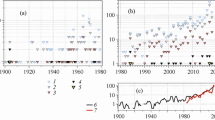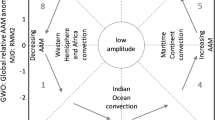Abstract
The Gini coefficient, Palma ratio, and the ratio of the percentage of tornadoes occurring on days with 20+ tornadoes to the percentage of tornadoes occurring on days with 1–9 tornadoes were used to measure the concentration of tornadoes in the USA for each year over the period 1954–2017. The Gini coefficient and Palma ratio were also used to measure the concentration of tornado power. All three metrics illustrate that most tornadoes are concentrated on relatively few days and that power is even more concentrated. Trend tests illustrate that tornadoes are becoming more concentrated over time, but the power dissipated by tornadoes is becoming less concentrated. Despite the declining trend, most of the power dissipated by tornadoes remains highly concentrated on relatively few days.










Similar content being viewed by others
References
Agee E, Childs S (2014) Adjustments in tornado counts, F-scale intensity, and path width for assessing significant tornado destruction. J Appl Meteorol Climatol 53:1494–1505
Agee E, Taylor L (2019) Historical analysis of U.S. tornado fatalities (1808–2017): population, science, and technology. Wea Clim Soc 11:355–368
Agee E, Larson J, Childs S, Marmo A (2016) Spatial redistribution of U.S. tornado activity between 1954 and 2013. J App Climatol Meteorol 55:1681–1697
Ash KD (2017) A qualitative study of mobile home resident perspectives on tornadoes and tornado protective actions in South Carolina. USA, Geojournal 82:533–552
Ashley WS (2007) Spatial and temporal analysis of tornado fatalities in the United States: 1880–2005. Wea Forecast 22:1214–1228
Ashley WS, Strader SM (2016) Recipe for disaster: how the dynamic ingredients of risk and exposure are changing the tornado disaster landscape. Bull Am Meteorol Soc 97:767–786
Ashley WS, Krmenec AJ, Schwantes R (2008) Vulnerability due to nocturnal tornadoes. Wea Forecast 23:795–807
Ashley WS, Strader SM, Rosencrants T, Krmenec AJ (2014) Spatiotemporal changes in tornado hazard exposure: the case of the expanding bull’s-eye effect in Chicago, Illinois. Wea Clim Soc 6:175–193
Boruff BJ, Easoz JA, Jones SD, Landry HR, Mitchem JD, Cutter SL (2003) Tornado hazards in the United States. Clim Res 24:103–117
Brooks HE, Carbin GW, March PT (2014) Increased variability of tornado occurrence in the United States. Science 346:349–352
Chaney PL, Weaver GS, Youngblood SA, Pitts K (2013) Household preparedness for tornado hazards: the 2011 disaster in DeKalb County, Alabama. Wea Clim Soc 5:345–358
Cobham A, Sumner A (2013) Is it all about the tails? The Palma measure of income inequality. Society for the Study of Economic Inequity. Working Paper Series. ECINEQ WP 2013 – 308. http://www.ecineq.org/milano/WP/ECINEQ2013-308.pdf. Accessed 17 June 2019
Cobham A, Schlögl L, Sumner A (2016) Inequality and the tails: the Palma proposition and ratio. Global Pol 7:25–36
Cohen J, Screen JA, Furtado JC, Barlow M, Whittleston D, Coumou D, Francis J, Dethloff K, Entekhabi D, Overland J, Jones J (2014) Recent Arctic amplification and extreme mid-latitude weather. Nat Geosci 7:627–637
Cutter SL, Boruff BJ, Shirley WL (2003) Social vulnerability to environmental hazards. Soc Sci Q 84:242–261
Dixon RW, Moore TW (2012) Tornado vulnerability in Texas. Wea Clim Soc 4:59–68
Doswell CA III, Carbin GW, Brooks HE (2012) The tornadoes of spring 2011 in the USA: an historical perspective. Weather 67:88–94
Ellis KN, Mason LR, Gassert KN, Elsner JB, Fricker T (2018) Public perception of climatological tornado risk in Tennessee, USA. Int J Biometeorol 62(9):1557–1566. https://doi.org/10.1007/s00484-018-1547-x
Elsner JB, Elsner SC, Jagger TH (2015) The increasing efficiency of tornado days in the United States. Clim Dyn 45:651–659
Elsner JB, Fricker T, Berry WD (2018) A model for U.S. tornado casualties involving interaction between damage path estimates of population density and energy dissipation. J Appl Meteorol Climatol 57:2035–2046
Elsner JB, Fricker T, Schroder Z (2019) Increasingly powerful tornadoes in the United States. Geophys Res Lett 46:392–398
Francis JA, Vavrus SJ (2015) Evidence for a wavier jet stream in response to rapid Arctic warming. Environ Res Lett 10:014005
Fricker T, Elsner JB (2015) Kinetic energy of tornadoes in the United States. PLoS One 10:E0131090. https://doi.org/10.1371/journal.pone.0131090
Fricker T, Elsner JB (2019) Unusually devastating tornadoes in the United States: 1995–2016. Ann Am Assoc Geogr 110:724–738. https://doi.org/10.1080/24694452.2019.1638753
Fricker T, Elsner JB, Jagger TH (2017) Population and energy elasticity of tornado casualties. Geophys Res Lett 44:3941–3949
Fuhrmann CM, Konrad CE III, Kovach MM, McLeod JT, Schmitz WG, Dixon PG (2014) Ranking of tornado outbreaks across the United States and their climatological characteristics. Wea Forecast 29:684–701
Gensini VA, Brooks HE (2018) Spatial trends in United States tornado frequency. npj Clim Atm Sci 1:38
Hancock MS (2016) reldist: Relative distribution methods. R package version 1.6-6
Hancock MS, Morris M (1999) Relative distribution methods in the social sciences. Springer, New York
Kendall MG (1970) Rank correlation methods. Charles Griffin, London
Klockow KE, Peppler RA, McPherson RA (2014) Tornado folk science in Alabama and Mississippi in the 27 April 2011 tornado outbreak. GeoJournal 79(6):791–804. https://doi.org/10.1007/s10708-013-9518-6
Konapala G, Mishra A, Leung LR (2017) Changes in temporal variability of precipitation over land due to anthropogenic forcings. Environ Res Lett 12:024009. https://doi.org/10.1088/1748-9326/aa568a
Kunkel K, Karl T, Brooks HE et al (2013) Monitoring and understanding trends in extreme storms. Bull Am Meteorol Soc 97:499–514
Mann HB (1945) Nonparametric tests against trend. Econometrica 13:245–259
Mann ME, Rahmstorf S, Kornhuber K, Steinman BA, Miller SK, Coumou D (2017) Influence of anthropogenic climate change on planetary wave resonance and extreme weather events. Sci Rep 7:45242
Masaki Y, Hanasaki N, Takahashi K, Hijoka Y (2014) Global-scale analysis on future changes in flow regimes using Gini and Lorenz asymmetry coefficients. Water Resour Res 50:4054–4078
Mercer AE, Shafer CM, Doswell CA III et al (2012) Synoptic composites of tornadic and nontornadic outbreaks. Mon Weather Rev 140:2590–2608
Merrell D, Simmons KM, Sutter D (2005) The determinants of tornado casualties and the benefits of tornado shelters. Land Econ 81:87–99
Moore TW (2017) On the temporal and spatial characteristics of tornadoes days in the United States. Atmos Res 184:56–65
Moore TW (2018) Annual and seasonal tornado trends in the contiguous United States and its regions. Int J Climatol 38:1582–1594
Moore TW, DeBoer TA (2019) A review and analysis of possible changes to the climatology of tornadoes in the United States. Prog Phys Geogr 43:365–390
Moore TW, McGuire (2019) Using the standard deviational ellipse to document changes to the spatial dispersion of seasonal tornado activity in the United States. npj Clim Atm Sci 2:21. https://doi.org/10.1038/s41612-019-0078-4
NWS (National Weather Service) (2019) Natural hazards statistics. https://www.nws.noaa.gov/os/hazstats.shtml. Accessed 9 June 2019
Palma JG (2011) Homogenous middles vs. heterogeneous tails, and the end of the “inverted-u”: the share of the rich is what it’s all about. Dev Chang 42:87–153
Pendergrass AG, Knutti R (2018) The uneven nature of daily precipitation and its change. Geophys Res Lett 45:11 980–11 988
Pohlert T (2018) trend: Non-parametric trend tests and change-point detection. R package version 1.1.1
Rajah K, O’Leary T, Turner A, Petrakis G, Leonard M, Westra S (2014) Changes to the temporal distribution of daily precipitation. Geophys Res Lett 41:8887–8894
Ramsdell JV Jr, Rishel JP (2007) Tornado climatology of the contiguous United States (Tech. Rep. Nos. NUREG/CR-4461, PNNL-15112). Pacific Northwest National Laboratory, Richland
Rosencrants TD, Ashley WS (2015) Spatiotemporal analysis of tornado exposure in five US metropolitan areas. Nat Hazards 78:121–140
Sangüesa C, Pizarro R, Ibañez A, Pino J, Rivera D, García-Chevesich P, Ingram B (2018) Spatial and temporal analysis of rainfall concentration using the Gini index and PCI. Water 10. https://doi.org/10.3390/w10020112
Schmidlin TW, Hammer BO, Ono Y, King PS (2009) Tornado shelter-seeking behavior and tornado shelter options among mobile home residents in the United States. Nat Hazards 48:191–201
Schultz DM, Richardson YP, Markowski PM et al (2014) Tornadoes in the central United States and the “clash of air masses”. Bull Am Meteorol Soc 94:1704–1712
Sen PK (1968) Estimates of the regression coefficient based on Kendall’s tau. J Am Stat Assoc 63:1379–1389
Senkbeil JC, Rockman MS, Mason JB (2012) Shelter seeking plans of Tuscaloosa residents for a future tornado event. Wea Clim Soc 4:159–171
Schroder Z, Elsner JB (2019) Quantifying relationships between environmental factors and power dissipation on the most prolific days in the largest tornado ‘outbreaks’. Int J Climatol 40:3150–3160. https://doi.org/10.1002/joc.63888
Simmons KM, Sutter D (2005) WSR-88D radar, tornado warnings, and tornado casualties. Wea Forcasting 20:301–310
Simmons KM, Sutter D (2008) Manufactured home building regulations and the February 2,2007 Florida tornadoes. Nat Hazards 46:415–425
Simmons KM, Sutter D (2011) Economic and societal impact of tornadoes. American Meteorological Society and University of Chicago Press, Chicago
SPC (Storm Prediction Center) (2019) Severe Weather Database files (1950–2017). https://www.spc.noaa.gov/wcm/. Accessed 9 June 2019
Strader SM, Ashley WS (2018) Finescale assessment of mobile home tornado vulnerability in the Central and Southeast United States. Wea Clim Soc 10:797–812
Strader SM, Pingel TJ, Ashley WS (2016) A Monte Carlo model for estimating tornado impacts. Meteorol Appl 23:269–281
Strader SM, Ashley WS, Pingel TJ, Krmenec AJ (2017a) Observed and projected changes in United States tornado exposure. Wea Clim Soc 9:109–123
Strader SM, Ashley WS, Pingel TJ, Krmenec AJ (2017b) Projected 21st century changed in tornado exposure, risk, and disaster potential. Clim Chang 141:301–313
Strader SM, Ashley WS, Pingel TJ, Krmenec AJ (2018) How land use alters the tornado disaster landscape. Appl Geogr 94:18–29
Strader SM, Ash K, Wagner E, Sherrod C (2019) Mobile home resident evacuation vulnerability and emergency service access during tornado events in the Southeast United States. Int J Disast Risk Re 38:101210. https://doi.org/10.1016/j.ijdrr.2019.101210
Sun Q, Miao C, Duan Q, Wang Y (2015) Temperature and precipitation changes over the Loess Plateau between 1961 and 2011, based on high-density gauge observations. Glob Planet Chang 132:1–10
Sun W, Miao C, Duan Q (2017) Changes in the spatial heterogeneity and annual distribution of observed precipitation across China. J Clim 30:9399–9416
Sutter D, Poitras MM (2010) Do people respond to low probability risks? Evidence from tornado risk and manufactured homes. J Risk Uncertain 40:181–196
Sutter D, Simmons KM (2010) Tornado fatalities and mobile homes in the United States. Nat Hazards 53:125–137
Theil H (1950) A rank-invariant method of linear and polynomial regression analysis. Proc K Ned Akad A Math 53:386, 521, 1397–392 (part I), 525 (part II), 1412 (part III)
Thomspon R, Vescio M (1998) The destruction potential index-A method for comparing tornado days. 19th Conf Severe Local Storms. Am Meteor Soc. Minneapolis, MN
Tippett MK, Cohen JE (2016) Tornado outbreak variability follows Taylor’s power law of fluctuation scaling and increases dramatically with severity. Nature Comm 7:10668
Tippett MK, Lepore C, Cohen JE (2016) More tornadoes in the most extreme U.S. tornado outbreaks. Science 354:1419–1423
Verbout SM, Brooks HE, Leslie LM, Schultz DM (2006) Evolution of the US tornado database: 1954–2003. Wea Forecast 21:86–93
Author information
Authors and Affiliations
Corresponding author
Additional information
Publisher’s note
Springer Nature remains neutral with regard to jurisdictional claims in published maps and institutional affiliations.
Rights and permissions
About this article
Cite this article
Moore, T.W., Fricker, T. Tornadoes in the USA are concentrating on fewer days, but their power dissipation is not. Theor Appl Climatol 142, 1569–1579 (2020). https://doi.org/10.1007/s00704-020-03402-1
Received:
Accepted:
Published:
Issue Date:
DOI: https://doi.org/10.1007/s00704-020-03402-1




